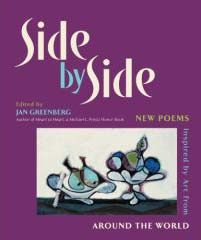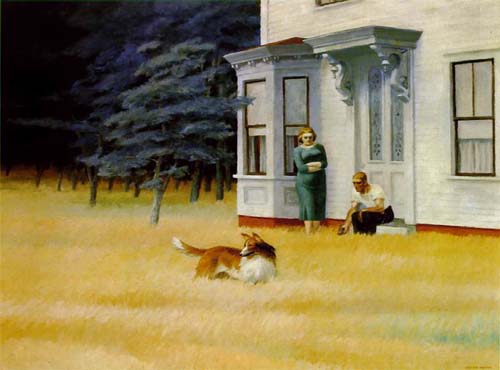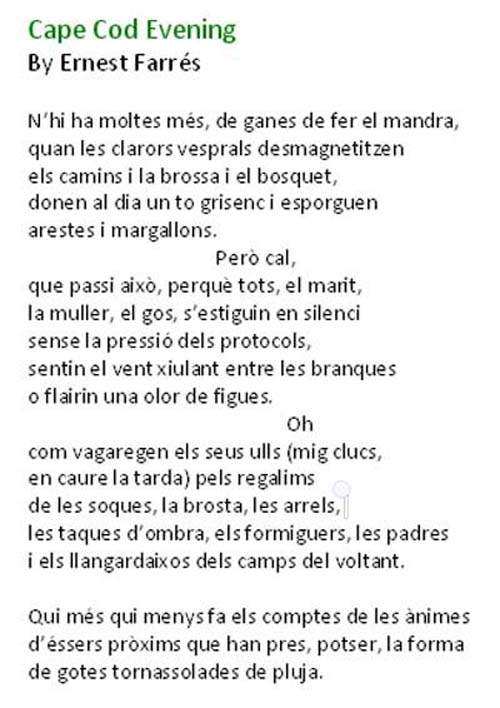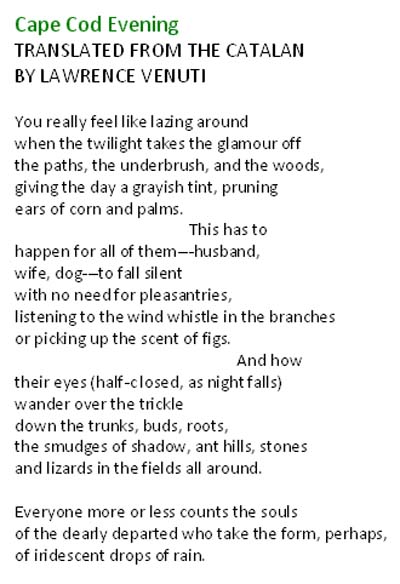Jan Greenberg’s Side by Side
 May 1st, 2008 by jules
May 1st, 2008 by jules
 Want to see something neat? Ekphrasis. Ekphrasis, I tell ya. That means, essentially, poetry inspired by art, and it’s my new favorite word. Little did I know there was a word for this. Ekphrasis. I like saying it. Here’s some ekphrasis in action, and it comes from Side by Side: New Poems Inspired by Art From Around the World (Abrams Books for Young Readers, May 2008), which I’ll tell you about in a moment. This is an anthology edited by Jan Greenberg, who brought us—amongst a handful of great titles—the Printz Honor Book, Heart to Heart: New Poems Inspired by Twentieth-Century American Art (Abrams, 2001).
Want to see something neat? Ekphrasis. Ekphrasis, I tell ya. That means, essentially, poetry inspired by art, and it’s my new favorite word. Little did I know there was a word for this. Ekphrasis. I like saying it. Here’s some ekphrasis in action, and it comes from Side by Side: New Poems Inspired by Art From Around the World (Abrams Books for Young Readers, May 2008), which I’ll tell you about in a moment. This is an anthology edited by Jan Greenberg, who brought us—amongst a handful of great titles—the Printz Honor Book, Heart to Heart: New Poems Inspired by Twentieth-Century American Art (Abrams, 2001).
For the record, I’m re-printing these two poems with permission from the publisher, and this Edward Hopper painting falls under Fair Use and all that fun stuff. Also, I know these poems are HUGE, but WordPress won’t cooperate when I need to type poems with unusual formatting / spacing / indentation, so I have to basically type them into Word and make them images. Anyway, moving on…


 Not only do I really like that poem and wanted to share it with you, but notice that what we have here is an original poem in the poet’s native language — in this instance, Catalan — which was then translated into English. Just as you can see them together here, in Greenberg’s anthology you can see them side-by-side on each page (hence, the book’s title. Ahem.) And all of the original poems were inspired by art work, which—of course—you also see on the same spread. Lovely.
Not only do I really like that poem and wanted to share it with you, but notice that what we have here is an original poem in the poet’s native language — in this instance, Catalan — which was then translated into English. Just as you can see them together here, in Greenberg’s anthology you can see them side-by-side on each page (hence, the book’s title. Ahem.) And all of the original poems were inspired by art work, which—of course—you also see on the same spread. Lovely.
Ekphrasis in action.
Artists from thirty-three countries are included here in an anthology divided into four sections—Stories, Voices, Expressions, and Impressions. Greenberg writes in the book’s Introduction:
Never mind that I knew very little about contemporary poetry outside America, or that, other than my high school French, I don’t speak or read another language. Still, I am a lover of art and poetry, curious about different cultures, and an insatiable traveler. This project gave me a chance to combine my passions. Also I strongly believe that the arts transcend geography and that, in this troubled world, they have the power to unite us, to inspire courage and hope.
All the poets and translators in the anthology are living, she adds, with the exception of Alexander Pushkin. She also explains that most of the poems were written or translated especially for this collection and that “{a} few chose to write in English and translate their poems into their native language.” Some of the poets are also artists (Betsy Bird adding in her detailed review: “Once in a while, the artists that have created some of these pieces have gone on to also write their own interpretive poems. I would have liked a little more notice paid to this form of poetry, which otherwise goes unremarked in the book. To my mind such poems should constitute their own separate section.”) Art work includes pieces by contemporary artists {Reha Yalnizcik; Wafaa S. Jdeed; Lawrence F. Sykes; Ernesto Neto; Nanezbah Nora Yazzie; and Shahzia Sikander, who is pictured here, because a) her work is beautiful and you should really visit her aforelinked site there, and b) on a painfully superficial level, I covet that shirt she’s wearing}; artists who lived as long ago as 1480 (Botticelli’s Portrait of a Young Man and Hans Memling’s Portrait of a Young Woman are included); and a little bit of everything else in between (Picasso, Matisse, Edvard Munch). The oldest pieces are from circa 1040 and the Banga Sayusang (Future Buddha), pictured below, from the early seventh century.
 The nicest touch of all in this already-handsome, well-designed, and all-around winning book is that the book closes with not just biographies of the poets but also the TRANSLATORS. This makes my interpreter-heart very happy. Biographies of the artists are also included, as well as a map of the world, showing where each poet, translator, and artist in the anthology lives or lived (though they’re not listed on the map, so you have to flip pages a lot—from map to biographies and back again—to get it straight).
The nicest touch of all in this already-handsome, well-designed, and all-around winning book is that the book closes with not just biographies of the poets but also the TRANSLATORS. This makes my interpreter-heart very happy. Biographies of the artists are also included, as well as a map of the world, showing where each poet, translator, and artist in the anthology lives or lived (though they’re not listed on the map, so you have to flip pages a lot—from map to biographies and back again—to get it straight).
This would be an excellent purchase for school libraries, in particular, and a wonderful resource for both middle school and high school art teachers and those teachers working on poetry units. As Greenberg puts it well in the intro:
“What have the poet and translators done? They have engaged in an act of seeing, determined to occupy the space between the eye and the object and to bridge the mysterious gap between two art forms. They were willing to entangle themselves in the mystery and to cross borders, both of geography and of genres.”
What a rewarding thing to ask students to do as well.
For other blog reviews of this title:
- As already mentioned above, Betsy Bird covered this in detail at A Fuse #8 Production (for those interested in the beginnings of a conversation about whether or not the image chosen for the book cover works, head on over there);
- Kelly Herold at Big A little a;
- and . . . I just stumbled upon this at I.N.K.’s blog (Interesting Nonfiction for Kids), which Kelly also links to: Jan Greenberg’s post from last Friday, “Notes to Myself on Writing.”
If I’ve missed any other blog reviews, please leave a comment and share yours.
Note: Poems are from SIDE BY SIDE: NEW POEMS INSPIRED BY ART FROM AROUND THE WORLD, copyright © 2008, posted by permission of Abrams Books for Young Readers. All rights reserved.

Oh, COOL.
I have reviewed another book of short stories based on sketches, and I think this is BEYOND cool – the fact that it’s a multicultural effort as well — Cape Cod to Catalan! — is inspired. I love that word Ekphrasis!!
I also love that word. And Shahzia Sikander’s shirt. And the whole concept of this book. Awesome find.
First, I own Heart to Heart. In fact, it’s on display in my living room, in a stack of books between two lions (yes, the NYPL ones.) So I believe I MUST own Side by Side. Done deal.
Second, I am so with you on the superficial love of the shirt. I couldn’t stop staring at the sleeves, even though I don’t like pink or lace.
Third, I love that both the originals and the translations are included. I only read a bit of French, but I’ll try to read anything in another language, just to feel the sounds on my tongue. As long as no one’s laughing at me.
Fourth, you know I saw the Hopper exhibit. He makes you want to write poetry. His work is some of the most conducive to ekphrasis that I know. Ok, that sounds pompous. I just mean that he makes my head explode, and I want to sit down and RESPOND when I see his work.
Thanks, guys. Sara, I’m with you on Hopper. I remember you saying you saw an exhibit, and I’m insanely jealous. I wonder if anyone’s ever done a book of Hopper-inspired poetry?
And isn’t Heart to Heart great, too?
Ernesto Neto’s site is really worth exploring, too.
Sara, I also love to look at poems in other languages, whether I understand them or not. I really, REALLY love that she has translator bios in here.
Many thanks for noticing Jan Greenberg’s book and especially for your appreciation of Ernest Farres’s poem and my translation.
In response to Jules’s question about “Hopper-inspired poetry,” Farres’s 2006 book “Edward Hopper” contains fifty poems, each based on one of the artist’s paintings. I have completed my English translation, and the project is now circulating among publishers (although it has also suffered a number of rejections–par for the course with translations in the US).
Excerpts from this project have appeared in various journals, including the online magazine Words without Borders (10/07), The Nation (12/31/07), Zoland Poetry (4/08), Two Lines (6/08), and World Literature Today (9/08).
[…] by a work of art. Here’s Kelly Herold’s review at Big A, little a, and here’s the review Jules posted at 7 Impossible Things Before […]
[…] by a work of art. Here’s Kelly Herold’s review at Big A, little a, and here’s the review Jules posted at 7 Impossible Things Before […]